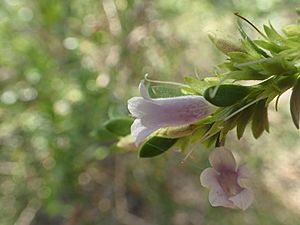Milky emu bush facts for kids
Quick facts for kids Milky emu bush |
|
|---|---|
 |
|
| Eremophila lactea in Kings Park, Western Australia | |
| Conservation status | |
| Scientific classification | |
| Genus: |
Eremophila (plant)
|
| Species: |
lactea
|
The Eremophila lactea, also known as the milky emu bush, is a special flowering plant. It belongs to the figwort family, called Scrophulariaceae. This plant is found only in Western Australia, which means it is endemic there.
It grows as an upright shrub. Its branches and leaves are mostly smooth, but they have white spots. These spots come from dried resin, which is a sticky substance plants make. The milky emu bush is a critically endangered plant. This means it is very rare and at high risk of disappearing forever. You can often find it in places that have been disturbed, like along roadsides.
Contents
What the Milky Emu Bush Looks Like
The milky emu bush is an upright shrub. It usually grows to be about 1 to 3.5 meters (3 to 11 feet) tall. Its branches are mostly smooth and have noticeable white blotches. These blotches are from dried resin.
Leaves of the Plant
The leaves do not have stalks and overlap each other. They are about 10 to 31 millimeters (0.4 to 1.2 inches) long. They are also 2 to 6 millimeters (0.08 to 0.24 inches) wide. The leaves are shaped like an ellipse or a spear. They often cover the smaller branches. Just like the branches, the leaves often have white spots from the dried resin.
Flowers of the Milky Emu Bush
The flowers grow in groups of 3 or 4. They appear where the leaves meet the stem. Each flower group sits on a small stalk about 2 to 3 millimeters (0.08 to 0.12 inches) long. These stalks often have white blotches too.
There are 5 green, oblong, or spear-shaped sepals. Sepals are like small leaves that protect the flower bud. They are usually 3 to 5.5 millimeters (0.12 to 0.22 inches) long. The petals are 8 to 13.5 millimeters (0.31 to 0.53 inches) long. They are joined together at the bottom to form a tube shape.
The outside of the flower tube is a pale lilac color. The inside is a deeper lilac with light purple spots. The outside of the petal tube is covered with tiny, sticky hairs. The inside of the petal tips is smooth. But the inside of the tube is full of long, soft hairs. The flower has 4 stamens, which are the parts that produce pollen. These stamens are completely hidden inside the petal tube.
When it Flowers and Fruits
The milky emu bush flowers between September and November. After flowering, it produces fruits. These fruits are oval to cylinder-shaped. They can grow up to 3.5 millimeters (0.14 inches) long.
How it Got its Name
The milky emu bush, Eremophila lactea, was first officially described in 1985. A botanist named Robert Chinnock wrote about it in a science journal called Nuytsia.
The second part of its scientific name, lactea, comes from a Latin word. "Lactea" means "milky." This name was chosen because of the white, milky resin. This resin can be seen on the branches, leaves, and flower stalks.
Where the Milky Emu Bush Lives
In 1999, there were only 547 known milky emu bush plants left in the wild. They were found in just four places. These places are along roadsides north of Esperance. This area is part of the Mallee region in Western Australia.
This plant often grows in areas that have been disturbed. It prefers sandy clay soil. Because it is so rare, the species was officially declared "Rare Flora" in 1996. Then, in 1998, it was listed as "Critically Endangered." This means it is very close to disappearing forever.
Threats to the Plant
The milky emu bush faces several dangers. These include road work that might damage the plants. Fires are also a big threat. Sometimes, people might accidentally harm the plants.
Protecting the Milky Emu Bush
The milky emu bush is listed as "Threatened Flora (Declared Rare Flora — Extant)". This classification is given by the Department of Environment and Conservation (Western Australia). An Interim Recovery Plan has been created to help protect this special plant. This plan helps guide efforts to save it from extinction.
Growing the Milky Emu Bush
The milky emu bush can be a good "filler" plant in gardens. However, strong winds can sometimes damage it. It can be a bit tricky to grow new plants from cuttings. But it can also be grafted onto another plant called Myoporum. This means joining a piece of the milky emu bush onto the roots of a Myoporum plant.
Plants that grow on their own roots can live in alkaline soils. This includes heavy clay. They can grow well in full sun or in partial shade. This shrub is also tough! It can handle both frost and dry weather.



